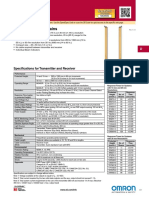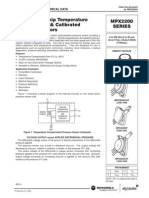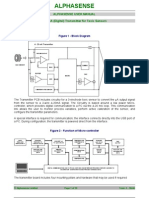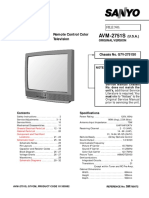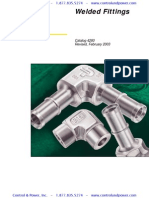MPU-A Series Hall Effect Geartooth Sensor Pick-Up: Features
MPU-A Series Hall Effect Geartooth Sensor Pick-Up: Features
Uploaded by
mcarrillogCopyright:
Available Formats
MPU-A Series Hall Effect Geartooth Sensor Pick-Up: Features
MPU-A Series Hall Effect Geartooth Sensor Pick-Up: Features
Uploaded by
mcarrillogOriginal Title
Copyright
Available Formats
Share this document
Did you find this document useful?
Is this content inappropriate?
Copyright:
Available Formats
MPU-A Series Hall Effect Geartooth Sensor Pick-Up: Features
MPU-A Series Hall Effect Geartooth Sensor Pick-Up: Features
Uploaded by
mcarrillogCopyright:
Available Formats
LT16 (side 1 of 2)
MPU-A Series Hall Effect Geartooth Sensor Pick-up
Features
Senses Motion of Ferrous Target Zero Speed Sensing Capabilities Digital Output Signal Large Operational Air Gap Wide Operating Temperature Range No Additional Conditioning Electronics Needed Immune to Hostile Environments Operates from 4.5 to 24 volts DC Supply Not subject to rotational orientation The MPU-A Series geartooth speed sensor provides zero speed sensing capabilities using solid state Hall Effect technology. This ready-to-use pick-up directly senses rotating ferrous gear type targets such as web speed gears, power transmission gears, conveyor speed and other similar gear-based shaft encoders. The MPU-A Series does not require a specially constructed target and is capable of sensing various target tooth sizes over wide ranges of airgap. The operational airgap achieved is independent of gear rotation speed. Internal temperature compensation allows this speed sensor to operate with minimal variation in performance over the specified temperature range. The small module size makes it ideal in applications where space considerations are of concern. The rugged design allows the operation of these sensor assemblies in hostile environments where dirt and oil are major problems. nally applied magnetic fields greater than 500 gauss. Fields of this magnitude are unusual in most environments but are present in MPU-A's and other magnetic sensors. It is recommended that the user not allow these devices to come into direct contact with each other during installation.
Absolute Maximum Ratings
Power Supply, VCC ....................................................... 24 V Ouput OFF Voltage ..................................................... 24 V Output ON Current, ISINK ........................................... 25 mA Operating Temperature Range, TA ................. -40 to +125C Storage Temperature Range, TS .................... -40 to +125C The MPU-A Series is supplied in a rugged cylindrical threaded aluminum housing 15/32 inch in diameter and 1 inch barrel length. It is designed to operate in temperature environments ranging from -40C to +125C.
Pick-up Installation (Figure 1)
GEAR ROTATION (size reduced) 15/32 NUTS MPU-A COMMON (blue) Vcc (Brown) SIGNAL OUT (Black) 2 MOUNTING BRACKET AIRGAP 1
Functional Block Diagram
Reg S1
M A G N E T
Figure 1 Gear Selection (Figure 2)
Vcc: (brown wire) EXTERNAL PULL-UP RESISTOR SIGNAL OUTPUT (black wire) COMMON (blue wire)
The MPU-A Series is designed to sense rotational speed of gears and gear-like targets. The optimal airgap performance is obtained using target materials with a high magnetic permeability such as low carbon steels.
S2
Airgap vs. Target Pitch (typical and 2 sigma)
Average Maximum Airgap -2 Sigma Maximum Airgap +2 Sigma Maximum Airgap .120 .100 .080 .060 .040 .020 0
Functional Description
The MPU-A Series contains an integrated circuit Hall Effect sensor in conjunction with a permanent magnet which supplies a bias field. The Hall sensor is internally protected against reverse battery conditions and operates over a wide temperature and supply voltage range. This unique integrated solution makes it less susceptible to supply and ground noise interference. The MPU-A Series requires no external electronics to further process the signal. The device is supplied with an open collector output capable of sinking 25mA and driving signals over wire lengths of up to 50 feet (15 meters). Note that the MPU-A Geartooth Sensor is sensitive to exterA-1-2881A-A
Airgap in inches
10 12 16 20 Gear Pitch (14.5 Spur Gear)
24
Figure 2
LT16 (side 2 of 2)
Performance Data (Figure 3)
Firepoint Shift in Degrees
Leading Edge Trailing Edge 0.7 0.6 0.5 0.4 0.3 0.2 0.1 0 0 1000 2000 3000 Target Speed RPM 4000 5000
The target described in Figure 3 was used in establishing fire point shift values on the accompanying Graph # 1 and Graph #2. The material used to construct the target was low carbon rolled steel 0.250" thick. The choice of dimensions for tooth width at 0.100" should be considered a practical minimum. The spacing between teeth and the depth of valleys can be adapted for specific requirements however performance of the sensor may be adversely affected. The minimum recommended dimensions are 0.1" at top of tooth, 0.1" between teeth and 0.15" tooth depth. These minimums will create sufficient magnetic flux change to actuate the sensor in all but the most extreme application at conditions. Non-repeating tooth patterns will provide timing and encoding capabilities for applications where more than speed sensing is desired. As a guideline, tooth dimensions approaching the minimum recommended will result in less working airgap, while larger teeth will result in a greater working airgap (see Figure #2).
Graph # 1
Leading Edge Trailing Edge 1.6 1.4 1.2 1.0 0.8 0.6 0.4 0.2 0 10 20 30 40 50 60 70 80 90 100 110 Airgap x 0.001"
Shift in Degrees
4.00"
14.4 Tooth Dimensions: 0.15" high 0.10" wide at top surface 25 teeth spaced 14.4
Figure 3 Electrical Hookup Instructions
The MPU-A Series pick-up is provided with an integral cable assembly. Brown: V + (Battery Positive, 4.5 - 24 Volts DC) Blue: Common (Battery Negative) Black: Signal Output All Dart products requiring digital pulse feedback are designed with internal pull-up resistors. However, if the MPU-A is being used with a peripheral that does not have a pull-up resistor, then the resistor value can be determined by use of the following formula: (VCC - .2) R = ISINK where ISINK is the desired sink current (typically 5 mA, maximum 20 mA). For 5 volt VCC and a desired 5 mA sink current, a resistor value of 960 is calculated (1K may be used).
Graph # 2 Dimensions and Wiring Connections
40.000 1.000 .438
.469
#22 wires (3) Vcc - Brown Gnd - Blue Out - Black
15/32-32 T.PI
Figure 3
A-1-2881A-B
You might also like
- Offworlders PDFDocument33 pagesOffworlders PDFZach Naylor89% (9)
- Repair Manual Genesis 260 350 GSM-GBDocument76 pagesRepair Manual Genesis 260 350 GSM-GBrumburac13100% (1)
- BBA (G) 6th Sem Result Sep 2020Document754 pagesBBA (G) 6th Sem Result Sep 2020Sachin ChadhaNo ratings yet
- Lumen - Marianorum ST STANISLAVDocument637 pagesLumen - Marianorum ST STANISLAVÓscar GorrizNo ratings yet
- MS4600 Datasheet en 201507 F266I-E-01Document7 pagesMS4600 Datasheet en 201507 F266I-E-01Eliezer DominguezNo ratings yet
- Two Wire Transmitter 4-20maDocument11 pagesTwo Wire Transmitter 4-20maEdgar MuñozNo ratings yet
- Traductor de PresiuneDocument22 pagesTraductor de PresiuneCamelia PăduraruNo ratings yet
- Sensor Capacitivo Omron E2k-CDocument8 pagesSensor Capacitivo Omron E2k-CClaudiney de SantanaNo ratings yet
- AMS90 - MechatronicsDocument20 pagesAMS90 - MechatronicsMukund FarjandNo ratings yet
- Brochure Btl's AmetekDocument86 pagesBrochure Btl's AmetekGerardo Cruz EspinosaNo ratings yet
- HortsmannDocument28 pagesHortsmannsivasankarNo ratings yet
- Bosch BPT S String Inverters PDFDocument4 pagesBosch BPT S String Inverters PDFUsmanNo ratings yet
- 177232D1Document6 pages177232D1Muhammad Usman SindhuNo ratings yet
- Tuc 6 WF ManualDocument92 pagesTuc 6 WF ManualSunil Singh86% (7)
- FAR3000 Chart Radar BrochureDocument8 pagesFAR3000 Chart Radar BrochureMiguel PerezNo ratings yet
- DS20930 1Document0 pagesDS20930 1centauro2013No ratings yet
- 9030 Plus™ Corrater Instrument User Manual: Serial NumberDocument55 pages9030 Plus™ Corrater Instrument User Manual: Serial NumberFaisal NaeemNo ratings yet
- Low Noise, Low Gain Drift, G 2000 Instrumentation AmplifierDocument20 pagesLow Noise, Low Gain Drift, G 2000 Instrumentation AmplifiervabecompNo ratings yet
- MPX2200Document9 pagesMPX2200Josimar Marquez GarciaNo ratings yet
- 4to20ma Digital Transmitter Toxic Alpha SenseDocument10 pages4to20ma Digital Transmitter Toxic Alpha SenseMara AjkaloNo ratings yet
- AlTek PickupsDocument40 pagesAlTek PickupsLuis Alfonso Andler C.100% (1)
- Servo Motors PSGDocument144 pagesServo Motors PSGjaimeasisaNo ratings yet
- A5000 Instruction ManualDocument6 pagesA5000 Instruction ManualTandin IgorNo ratings yet
- St6911 Ipt™ Acceleration Vibration Transducer St6917 Ipt™ Velocity Vibration TransducerDocument8 pagesSt6911 Ipt™ Acceleration Vibration Transducer St6917 Ipt™ Velocity Vibration TransducerProcurement PardisanNo ratings yet
- ACS712 Hall Effect Current SensorDocument7 pagesACS712 Hall Effect Current SensorWilliam BlackNo ratings yet
- Datasheet AEAT-6600Document11 pagesDatasheet AEAT-6600ArminNo ratings yet
- R Series RP RH AnalogDocument14 pagesR Series RP RH AnaloghaggNo ratings yet
- Receptor AM CA3088Document5 pagesReceptor AM CA3088Erick Dos SantosNo ratings yet
- Data 0006Document16 pagesData 0006richard anishNo ratings yet
- ADF4602Document36 pagesADF4602Pavan ChavariyaNo ratings yet
- Catalog ION 6200Document12 pagesCatalog ION 6200eltromeNo ratings yet
- MPX200Document8 pagesMPX200Hugo ContrerasNo ratings yet
- 3 Waukesha Gas Engine Maintenance ManualDocument75 pages3 Waukesha Gas Engine Maintenance ManualMamunNo ratings yet
- Ad8318 2Document24 pagesAd8318 2Ounce SaksanguanmanoonNo ratings yet
- Load Cell AmplifierDocument2 pagesLoad Cell AmplifiercanopusinstrumentsNo ratings yet
- Automatic Transfer SwitchesDocument20 pagesAutomatic Transfer SwitchesgianmantNo ratings yet
- F FL LO OW W: Vampire - Electronic IndicatorDocument3 pagesF FL LO OW W: Vampire - Electronic IndicatorscribdkhatnNo ratings yet
- ATS692 H DatasheetDocument12 pagesATS692 H Datasheetshivani_mehrotra_8No ratings yet
- Circuit Breaker AnalyzerDocument10 pagesCircuit Breaker AnalyzerarifNo ratings yet
- Upower Analog 2Q08 Calpoly SM FinalDocument36 pagesUpower Analog 2Q08 Calpoly SM FinalSteveAbonyiNo ratings yet
- Mpx2050 Data SheetDocument9 pagesMpx2050 Data SheetKarthi Manthangudi SellanNo ratings yet
- Control Circuit Wiring Variador V1000 YaskawaDocument8 pagesControl Circuit Wiring Variador V1000 YaskawaAndrés RamírezNo ratings yet
- Aitek Magnetic Pickups MPU Cat08 - SensorsDocument40 pagesAitek Magnetic Pickups MPU Cat08 - SensorsJose Luis Castro Aguilar0% (1)
- Alsa Alsatom SU MPC - Service ManualDocument37 pagesAlsa Alsatom SU MPC - Service ManualJuanNo ratings yet
- FCI Catalogue 2011 PDFDocument32 pagesFCI Catalogue 2011 PDFMonish KrishnaNo ratings yet
- OP07x Precision Operational Amplifiers: 1 Features 3 DescriptionDocument21 pagesOP07x Precision Operational Amplifiers: 1 Features 3 Descriptionraulst1No ratings yet
- 6W Dual-Channel AF Power Amplifier: Package Dimensions FeaturesDocument10 pages6W Dual-Channel AF Power Amplifier: Package Dimensions FeaturesDanielNo ratings yet
- Pressure Transmitter ST3000 HoneywellDocument30 pagesPressure Transmitter ST3000 HoneywellOmar AbdussaidNo ratings yet
- LCD Display VID29 - Manual - EN-080606Document10 pagesLCD Display VID29 - Manual - EN-080606RacielMCNo ratings yet
- Tektronix DMM4020 Digital Multimeter Datasheet 6Document12 pagesTektronix DMM4020 Digital Multimeter Datasheet 6JumbosizeNo ratings yet
- CA3080Document12 pagesCA3080yusufwpNo ratings yet
- M XxuywDocument13 pagesM XxuywRenganathan KrishnanNo ratings yet
- Features Description: FM IF SystemDocument7 pagesFeatures Description: FM IF Systemlu1agpNo ratings yet
- MPX10GSDocument9 pagesMPX10GSJoseph BurgosNo ratings yet
- Acterna OLA-15B Optical Attenuator Data SheetDocument2 pagesActerna OLA-15B Optical Attenuator Data Sheetscribd01No ratings yet
- JVC AV-21M315 - M335-Service - Manual PDFDocument32 pagesJVC AV-21M315 - M335-Service - Manual PDFkilol0No ratings yet
- MLX91205 DatasheetDocument14 pagesMLX91205 DatasheetRicardo ReisNo ratings yet
- Sanyo Avm2751s Service ManualDocument26 pagesSanyo Avm2751s Service ManualKastaliaNo ratings yet
- Analog Dialogue, Volume 48, Number 1: Analog Dialogue, #13From EverandAnalog Dialogue, Volume 48, Number 1: Analog Dialogue, #13Rating: 4 out of 5 stars4/5 (1)
- Reference Guide To Useful Electronic Circuits And Circuit Design Techniques - Part 2From EverandReference Guide To Useful Electronic Circuits And Circuit Design Techniques - Part 2No ratings yet
- Reference Guide To Useful Electronic Circuits And Circuit Design Techniques - Part 1From EverandReference Guide To Useful Electronic Circuits And Circuit Design Techniques - Part 1Rating: 2.5 out of 5 stars2.5/5 (3)
- Rev - B - Asp 5009 FRP SPC 30-10-2020Document139 pagesRev - B - Asp 5009 FRP SPC 30-10-2020Cuong Nguyen100% (1)
- Double Entry Journal Source 4Document2 pagesDouble Entry Journal Source 4api-383729698No ratings yet
- Eazy CLOT User ManualDocument29 pagesEazy CLOT User ManualKarthik RajaNo ratings yet
- Ibabm-Ddcs-Monitor v1.8 en A4Document26 pagesIbabm-Ddcs-Monitor v1.8 en A4Deepak PatelNo ratings yet
- Gi SurgeryDocument51 pagesGi SurgeryViky SinghNo ratings yet
- IoT AssignmentDocument3 pagesIoT Assignmentminichel100% (1)
- Dash (Dark Coin) FINAL - Charlotte LargeDocument9 pagesDash (Dark Coin) FINAL - Charlotte LargeBheeda ANo ratings yet
- SDFDocument79 pagesSDFtangwanlu9177No ratings yet
- IM NO.: IM-PROFED8-2NDSEM-2020-2021 College of Teacher Education Bayombong CampusDocument9 pagesIM NO.: IM-PROFED8-2NDSEM-2020-2021 College of Teacher Education Bayombong CampusXyra BallesterosNo ratings yet
- Internship Report - ShivaliDocument39 pagesInternship Report - ShivaliDhanapan KeithellakpamNo ratings yet
- X Eng PDFDocument3 pagesX Eng PDFSRGS MusicNo ratings yet
- TLE Cookery10 Q4 W3 V4Document7 pagesTLE Cookery10 Q4 W3 V4Maria Rose Tariga Aquino100% (2)
- Current Affairs January 2018 PDFDocument51 pagesCurrent Affairs January 2018 PDFDuma DumaiNo ratings yet
- Customer Satisfaction and Brand Loyalty in Big BasketDocument73 pagesCustomer Satisfaction and Brand Loyalty in Big BasketUpadhayayAnkurNo ratings yet
- Converting Rubber Seals To TPE by Gemini Plastics Inc GPIDocument11 pagesConverting Rubber Seals To TPE by Gemini Plastics Inc GPIRui TsaiNo ratings yet
- Surface Moisture in Fine Aggregate: Standard Test Method ForDocument3 pagesSurface Moisture in Fine Aggregate: Standard Test Method ForCheong Fung TingNo ratings yet
- University of Calcutta: SyllabiDocument42 pagesUniversity of Calcutta: SyllabiArif Zaman40% (5)
- Latest Salary SlipsDocument8 pagesLatest Salary SlipsFarhan HaqueNo ratings yet
- Gmail - Brownie Pets BadgeDocument2 pagesGmail - Brownie Pets Badgeapi-454987981No ratings yet
- Lecture 13 - Optical Indicatrix and Conoscopic MicrosDocument24 pagesLecture 13 - Optical Indicatrix and Conoscopic MicrosBaiq Safika WulansariNo ratings yet
- Retail Management-Lecture PlanDocument3 pagesRetail Management-Lecture Plang_malethaNo ratings yet
- Parker Welded FittingsDocument28 pagesParker Welded Fittingsscribd_thakurNo ratings yet
- Spanking Children Is A Form of DisciplineDocument1 pageSpanking Children Is A Form of DisciplineApril GllcNo ratings yet
- Kenkyo Kenjitsu - 04 - High School Second Year (CH 111-151)Document268 pagesKenkyo Kenjitsu - 04 - High School Second Year (CH 111-151)andilNo ratings yet
- Best Practices For Complex Liability ClaimsDocument62 pagesBest Practices For Complex Liability ClaimsAPAResultsNo ratings yet
- 22 BBookDocument173 pages22 BBookKevin LeNo ratings yet
- Ano Letivo 2024 4º Bimestre: Atividade Referente A: Multi - Word Verbs / Phrasal VerbsDocument2 pagesAno Letivo 2024 4º Bimestre: Atividade Referente A: Multi - Word Verbs / Phrasal VerbsmapamentalenzoNo ratings yet




